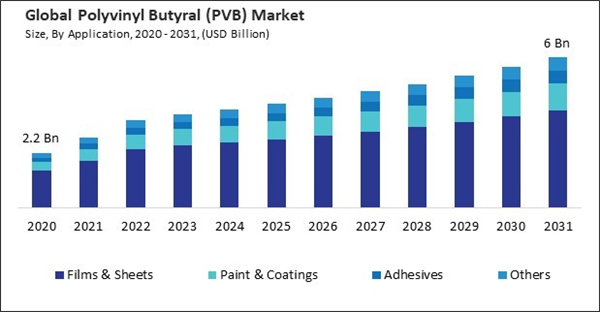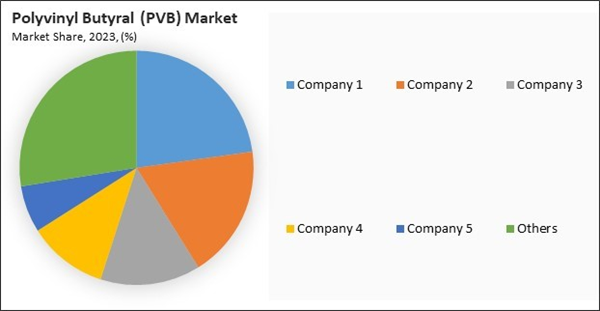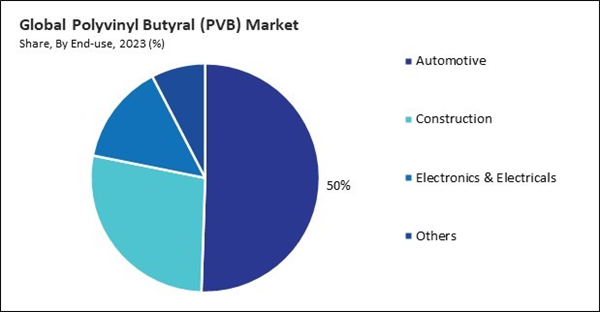The Global Polyvinyl Butyral (PVB) Market size is expected to reach $6 billion by 2031, rising at a market growth of 6.3% CAGR during the forecast period. In the year 2023, the market attained a volume of 6,41,566.2 tonnes experiencing a growth of 24.3% (2020-2023).
The construction industry in North America is growing, supported by infrastructure development projects, urbanization, and population growth. Renovation and retrofitting projects in North America often involve the replacement of traditional glass with PVB-based laminated glass. The construction industry in North America is increasingly focused on energy efficiency and sustainability, driving the demand for green building materials. Consequently, the North American region would acquire nearly 30% of the total market share by 2031. Also, the US construction industry would utilize 54,968.5 tonnes of this chemical by 2031.
Rapid urbanization increases construction activities, including residential buildings, commercial complexes, and infrastructure projects. Moreover, the growing demand for architectural glazing solutions in urban areas drives the demand for PVB-based laminated glass. Therefore, the market is expanding significantly due to rapid urbanization and infrastructure development.
Additionally, the increasing use of numerous electronic devices such as automobile displays, smartphones, tablets, laptops, and televisions drives the demand for electronic displays. The increasing use of numerous electronic devices such as automobile displays, smartphones, tablets, laptops, and televisions drives the demand for electronic displays. Thus, because of the rising demand for electronic displays, the market is anticipated to grow significantly.
However, Price fluctuations of PVB-related raw materials, including acetone, butyraldehyde, and vinyl alcohol, can cause PVB manufacturers to experience cost instability. Volatility in raw material prices can affect industries that rely on PVB-based products, such as the automotive, construction, and electronics industries. Thus, high volatility in raw material prices can slow down the growth of the market.
The leading players in the market are competing with diverse innovative offerings to remain competitive in the market. The above illustration shows the percentage of revenue shared by some of the leading companies in the market. The leading players of the market are adopting various strategies in order to cater demand coming from the different industries. The key developmental strategies in the market are Acquisitions, and Partnerships & Collaborations.
The construction industry in North America is growing, supported by infrastructure development projects, urbanization, and population growth. Renovation and retrofitting projects in North America often involve the replacement of traditional glass with PVB-based laminated glass. The construction industry in North America is increasingly focused on energy efficiency and sustainability, driving the demand for green building materials. Consequently, the North American region would acquire nearly 30% of the total market share by 2031. Also, the US construction industry would utilize 54,968.5 tonnes of this chemical by 2031.
Rapid urbanization increases construction activities, including residential buildings, commercial complexes, and infrastructure projects. Moreover, the growing demand for architectural glazing solutions in urban areas drives the demand for PVB-based laminated glass. Therefore, the market is expanding significantly due to rapid urbanization and infrastructure development.
Additionally, the increasing use of numerous electronic devices such as automobile displays, smartphones, tablets, laptops, and televisions drives the demand for electronic displays. The increasing use of numerous electronic devices such as automobile displays, smartphones, tablets, laptops, and televisions drives the demand for electronic displays. Thus, because of the rising demand for electronic displays, the market is anticipated to grow significantly.
However, Price fluctuations of PVB-related raw materials, including acetone, butyraldehyde, and vinyl alcohol, can cause PVB manufacturers to experience cost instability. Volatility in raw material prices can affect industries that rely on PVB-based products, such as the automotive, construction, and electronics industries. Thus, high volatility in raw material prices can slow down the growth of the market.
The leading players in the market are competing with diverse innovative offerings to remain competitive in the market. The above illustration shows the percentage of revenue shared by some of the leading companies in the market. The leading players of the market are adopting various strategies in order to cater demand coming from the different industries. The key developmental strategies in the market are Acquisitions, and Partnerships & Collaborations.
Driving and Restraining Factors
Drivers- Rapid urbanization and infrastructure development
- Rising demand for electronic displays
- Expansion of the automotive industry
- High volatility in raw material prices
- Significant regulatory compliance challenges
- Rising focus on energy efficiency and sustainability
- Increasing consumer awareness and demand
- Lack of supply chain disruption
- Limited availability of skilled labor
End-use Outlook
Based on end-use, the market is classified into automotive, construction, electronics & electricals, and others. The construction segment acquired 28% revenue share in the market in 2023. In terms of volume, the segment recorded 1,66,037.3 tonnes in 2023. The construction segment increasingly focuses on energy efficiency and sustainability, driving the demand for green building materials. PVB-based laminated glass improves energy efficiency by reducing buildings' heat transmission, UV radiation, and solar glare.Application Outlook
By application, the market is categorized into films & sheets, paint & coatings, adhesives, and others. The paint & coatings segment covered a 17.2% revenue share in the market in 2023. In terms of volume, the segment registered 1,17,823.6 tonnes in 2023. PVB improves the adhesion of coatings to substrates such as metal, wood, concrete, and plastics. It creates a robust adhesion with the substrate, thereby improving the longevity as well as the durability of the coating.Regional Outlook
Region-wise, the market is analyzed across North America, Europe, Asia Pacific, and LAMEA. In 2023, the Asia Pacific region led the market by generating 37% revenue share. The Asia Pacific region is experiencing rapid urbanization, population growth, and infrastructure development. Asia-Pacific is a significant center for the manufacturing of automobiles, with India, China, Japan, and South Korea at the forefront of the sector.List of Key Companies Profiled
- Kuraray Co., Ltd.
- Eastman Chemical Company
- Sekisui Chemical Co. Ltd.
- Chang Chun Group
- Huakai Plastic (Chongqing) Co.,Ltd.
- Everlam BV
- Tridev Resins (India) Pvt. Ltd.
- WMC Glass
- Perry Chemical Corp.
- Shark Solutions ApS
Market Report Segmentation
By Application (Volume, Tonnes, USD Billion, 2020-2031)- Films & Sheets
- Paint & Coatings
- Adhesives
- Others
- Automotive
- Construction
- Electronics & Electricals
- Others
- North America
- US
- Canada
- Mexico
- Rest of North America
- Europe
- Germany
- UK
- France
- Russia
- Spain
- Italy
- Rest of Europe
- Asia Pacific
- China
- Japan
- India
- South Korea
- Australia
- Malaysia
- Rest of Asia Pacific
- LAMEA
- Brazil
- Argentina
- UAE
- Saudi Arabia
- South Africa
- Nigeria
- Rest of LAMEA
Table of Contents
Chapter 1. Market Scope & Methodology
Chapter 2. Market at a Glance
Chapter 3. Market Overview
Chapter 4. Competition Analysis - Global
Chapter 5. Global Polyvinyl Butyral (PVB) Market by Application
Chapter 6. Global Polyvinyl Butyral (PVB) Market by End-use
Chapter 7. Global Polyvinyl Butyral (PVB) Market by Region
Chapter 8. Company Profiles
Companies Mentioned
- Kuraray Co., Ltd.
- Eastman Chemical Company
- Sekisui Chemical Co. Ltd.
- Chang Chun Group
- Huakai Plastic (Chongqing) Co.,Ltd.
- Everlam BV
- Tridev Resins (India) Pvt. Ltd.
- WMC Glass
- Perry Chemical Corp.
- Shark Solutions ApS
Methodology

LOADING...











